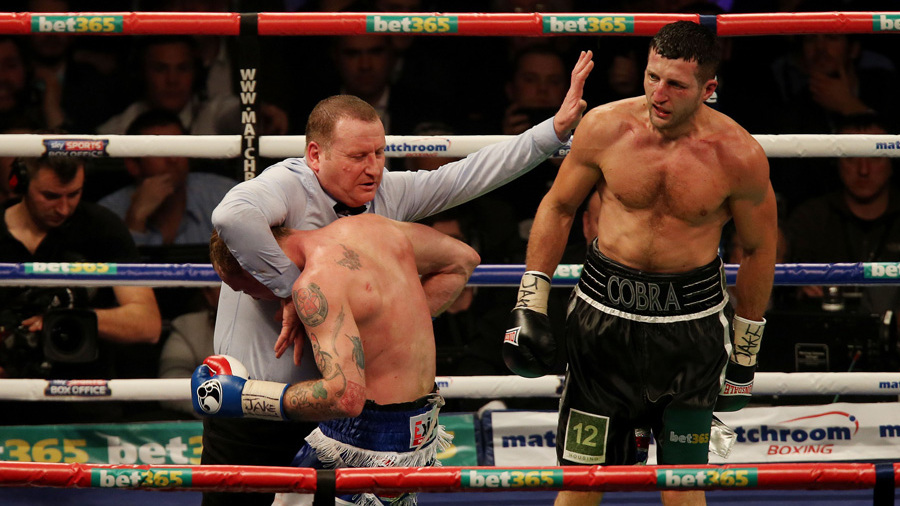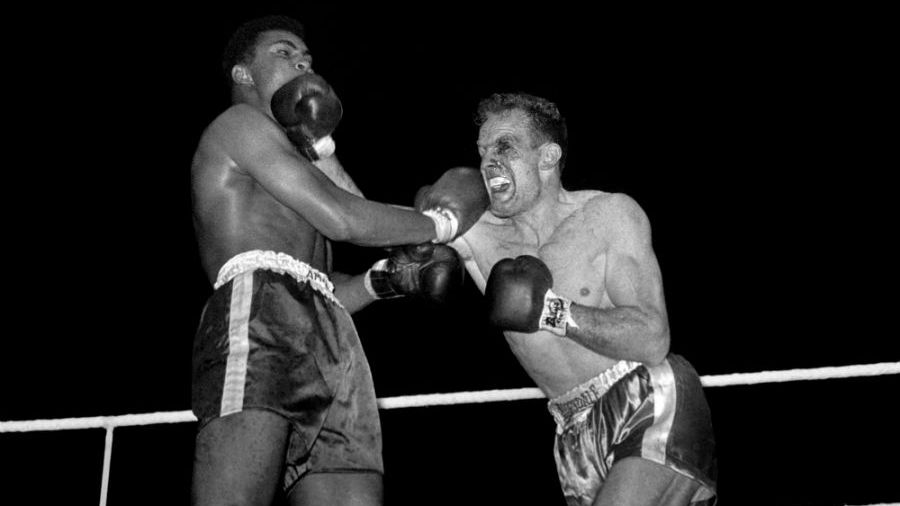
When Carl Froch and George Groves are left to fight in the Wembley ring this Saturday, separated before the first bell by the American referee Charlie Fitch, they will be part of a glorious, bloody, wet and often eccentric British tradition of outdoor fights.
Our 'Enry, the brave Henry Cooper, was cut to shreds twice by Muhammad Ali outdoors - the first time at Wembley and the second at Highbury - in fights that defined an era. The black and white pictures of their two iconic fights, taken long before nightfall added an unforgettable black backdrop, show a barren landscape of canvas chairs and empty stands.
When a promoter takes a fight outdoors he takes a risk and in Britain that risk involves rain: If the fight had been last Saturday then both could have entered the ring in canoes! When Frank Bruno lost to Lennox Lewis in a savage fight in Cardiff Arms Park in 1993 the weather was abysmal and big Frank came to the ring with his boxing boots wrapped in several plastic bags from Tesco. It helped and for a few rounds Lewis was sliding all over the place; it only helped for a few rounds.
Buncey's Vaults
- It was Wembley Stadium in September and Frank Bruno was the new WBC heavyweight champion of the world. "I've done it. I'm just over the moon," said Bruno, who had won a version of the world heavyweight title at the fourth attempt.
- "It was very, very rough. I took some shots but I held on. I just want to go home."
- The last round was hard to watch with Oliver McCall, the champion, needing a knockout and Bruno looking like he was ready to get knocked out.
- The final bell sounded and Bruno released a howl of relief. He had done it. I finished the report with: "For anybody inside Wembley last night, it would surely be one of the sweetest moments of their lives."
- Let's hope people think the same this weekend.
- As reported in the The Sunday Telegraph, September 3, 1995.
It was outdoors in Blackpool's Stanley Park in August 1962 that two heavyweights fought in their bare feet in a mad attempt to get some traction in the wet ring.
It is said that American Howard King was sent crashing along the canvas, water spraying, before his body slid to a halt under the bottom rope; Brian London, the local idol, won the comic outing that took place at the end of two solid hours of rain.
It was torrential rain that knocked about 30,000 off the gate when the undisputed King of the Outdoor Ring Jack Petersen fought Germany's Walter Neusel at Wembley in June 1933. In the days before the fight a fearsome heatwave swept the land, raising hopes that the warm weather would swell the gate to over 80,000.
The rematch ended with a cut and bruised Petersen retiring at the end of the tenth. Petersen fought outdoors in front of 50,000 or more four times and holds the official outdoor record with 90,000 at both his Jack Doyle fight, which was at White City Stadium in 1933, and the Len Harvey scrap the following year back at the glorious beast that was White City Stadium.

In what sounds rather apocalyptic there are tales from a show at White City Stadium in July 1939 that involve hundreds of cars being abandoned in the street as gridlock stopped all movement.
The punters simply got out and walked to the turnstiles to watch Len Harvey fight Jock McAvoy. The fight was won by Harvey, something of an idol at the time, and the crowd that day was probably close to 100,000 people; there are contemporary reports of as many as 250,000 trying to storm the gates and gain entry.
It was clearly a helluva night and ring historians have suggested that the wildness was because World War Two was imminent and people were just having one last proper night out. Or, they simply wanted to storm the gates and not pay!
Just a few hundred feet from where the old White City Stadium crumbled to a demolition death, which started in 1984, stands Loftus Road. It is not a sporting palace but for about 150,000 (and counting) Irishmen and women it will forever be a boxing shrine. The official attendance on the night in June 1985 when Barry McGuigan won the WBA featherweight title from the brilliant Eusebio Pedroza was under 30,000... however, I have yet to meet an Irishman who was NOT there!
During the last 20 years some grounds and other outdoor venues have been adapted for smaller fights, attracting crowds of under 10,000. However, the most recent exception was possibly the 2012 fight at Upton Park between Del Boy Chisora and David Haye, when once again a Haye fight was decimated by the heavens and as many as 15,000 stayed at home and stayed dry; when Haye fought Wladimir Klitschko the previous summer it is calculated that about 25,000 stayed away from the Imtech-Arena in Hamburg because of the sickening weather.
Incidentally, when Haye fought Wlad he got lost walking from his changing room to the ring (I kid you not). His boots were wet, which was certainly not good for his injured toe, and so he made adjustments for the Chisora fight and wore a pair of trainers. It was an ugly look but it worked and when he screwed his final punches his toes were digging deep into the canvas like a crab on a damp sandy beach.
On Saturday there will be no bare-feet brawlers, the rain will not trouble the giant event or those lucky enough to be covered by roof and, I like to think, the very humble Jack Petersen would be very proud to have his attendance records pushed so close.

© ESPN Sports Media Ltd
 Steve Bunce has been ringside in Las Vegas over 50 times, he has been at five Olympics and has been writing about boxing for over 25 years for a variety of national newspapers in Britain, including four which folded! It is possible that his face and voice have appeared on over 60 channels worldwide in a variety of languages - his first novel The Fixer was published in 2010 to no acclaim; amazingly it has been shortlisted for Sports Book of the Year.
Steve Bunce has been ringside in Las Vegas over 50 times, he has been at five Olympics and has been writing about boxing for over 25 years for a variety of national newspapers in Britain, including four which folded! It is possible that his face and voice have appeared on over 60 channels worldwide in a variety of languages - his first novel The Fixer was published in 2010 to no acclaim; amazingly it has been shortlisted for Sports Book of the Year.

